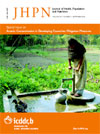
|
The Journal of Health, Population and Nutrition
icddr,b
ISSN: 1606-0997
EISSN: 1606-0997
Vol. 33, No. 2, 2015, pp. 1-9
|
 Bioline Code: hn15043
Bioline Code: hn15043
Full paper language: English
Document type: Research Article
Document available free of charge
|
|
|
The Journal of Health, Population and Nutrition, Vol. 33, No. 2, 2015, pp. 1-9
| en |
High prevalence of typhoidal Salmonella enterica  serovars excreting food handlers in Karachi-Pakistan: a probable factor for regional typhoid endemicity serovars excreting food handlers in Karachi-Pakistan: a probable factor for regional typhoid endemicity
Siddiqui, Taranum Ruba; Bibi, Safia; Mustufa, Muhammad Ayaz; Ayaz, Sobiya Mohiuddin & Khan, Adnan
Abstract
Background: Typhoid fever is the persistent cause of morbidity worldwide. Salmonella enterica serovar’s carriers
among food handlers have the potential to disseminate this infection on large scale in the community. The
purpose of this study was to determine the prevalence of typhoidal S. enterica serovars among food handlers of
Karachi.
Methods: This cross-sectional study was conducted in Karachi metropolis. A total of 220 food handlers were
recruited on the basis of inclusion criteria from famous food streets of randomly selected five towns of Karachi.
Three consecutive stool samples were collected from each food handler in Carry Blair transport media. Culture,
biochemical identification, serotyping, and antimicrobial susceptibility tests for S. enterica serovars were done.
Results: Out of 220 food handlers, 209 consented to participate, and among them, 19 (9.1 %) were positive for
S. enterica serovars. Serotyping of these isolates showed that 9 (4.3 %) were typhoidal
S. serovars while 10 (4.7 %)
were non-typhoidal S. serovars. Of the typhoidal S. serovars, 7 were S. enterica serovar Typhi and 1 each of S.
enterica serovar Paratyphi A and B. The resistance pattern of these isolates showed that 77.7 % were resistant to
ampicillin and 11.1 % to cotrimoxazole. All typhoidal S. enterica serovars isolates were sensitive to chloramphenicol,
ceftriaxone, cefixime, nalidixic acid, and ofloxacin.
Conclusions: Carrier rate of typhoidal S. enterica serovars in food handlers working in different food streets of
Karachi is very high. These food handlers might be contributing to the high endemicity of typhoid fever in Karachi,
Pakistan.
Keywords
Typhoid fever; Diarrhea; Endemics; Salmonella enterica serovars; Carriers
|
| |
© Copyright 2015 - The Journal of Health, Population and Nutrition
Alternative site location: http://www.jhpn.net
|
|
